Time States—Contradiction and Accordance is an exhibition, co-organized by Seoul National University Museum of Art (SNUMoA) and Arumjigi Culture Keepers Foundation. Arumjigi is a non-profit organization that was established in 2001 with the central mission of preserving and illuminating the beauty of Korean culture through creativity, and this exhibition is a testament to its commitment to this central mission. Of the 175 artworks that are featured, 100 of them are from the non-profit’s own collection.
Time States—Contradiction and Accordance explores the broad theme of “time” and pinpoints its focus on the concept of Eigenzeit, a German term roughly meaning “one’s own time.” The wall of text at the beginning of the exhibition offers a detailed elaboration. Eigenzeit refers to “the time related to a specific period of life, leading from childhood, through adolescence, adulthood, old age, and ultimately death, that is captured through life experiences.”

The beginning of the exhibition
The Inspiration of Eigenzeit
With the frenzied hustle and bustle of modern living, human beings are driven towards constant, forward progress. We are mesmerized by the prospect of advancement and bristle with excitement at the thought of the novelties that the future must hold. This constant pursuit of the new, however, has warped our perception of time. In our obsession with the new and futuristic, the past is cast aside as useless and outdated. Today, people seldom slow down to reflect upon the transcendent meaning of what already exists and to truly indulge in their individual sense of “now.” In other words, Eigenzeit is lost.
Time States—Contradiction and Accordance exhibits transitional art, which blends contemporary and traditional art styles, backdropped by the common thread of Korean culture and tradition. These artworks reflect the beauty of - and the need to - look to the familiar for inspiration and perspective. Perhaps only when we take the time to immerse ourselves in what we already have can Eigenzeit be regained.
The exhibition is divided into three sections: “Today, Universal Poem,” “Lasting Sensation,” and “Remembrance or Existence.”
“Today, Universal Poem”
One of the artists spotlighted in “Today, Universal Poem” is BoMin Kim. A trademark style featured in Kim’s landscape paintings is the merging of urbanscapes with historical scenes. By composing such pieces, she visualizes the connection between tradition and modernity and acknowledges that the past and the present are not two distinct entities.
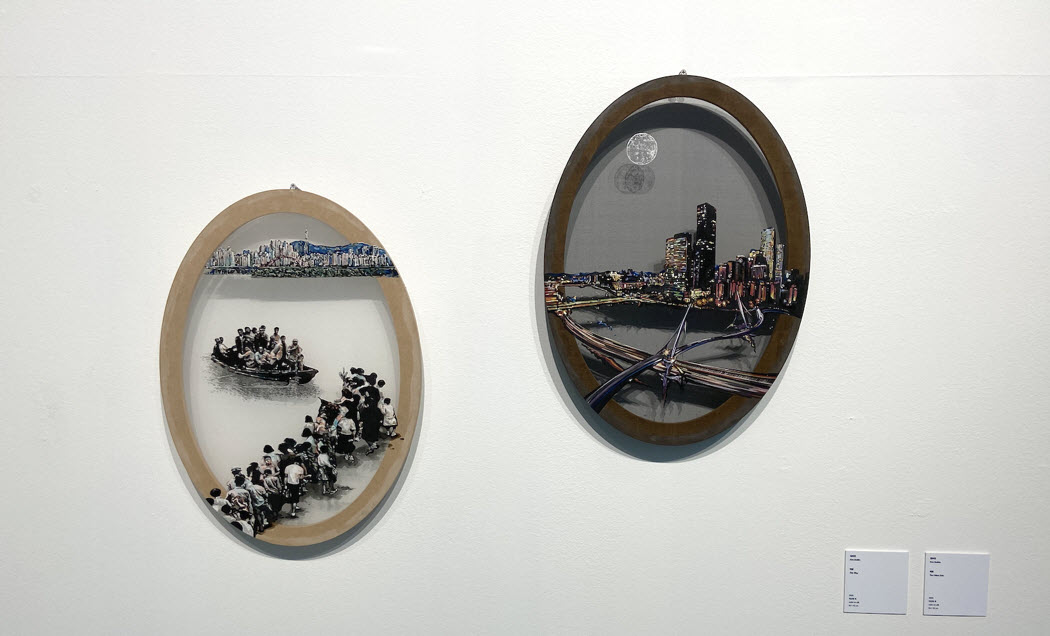
This Way (left) and The Other Side (right)
The pieces This Way and The Other Side are a set of silk paintings in oval frames evoking airplane windows. The former features people crowded onto and waiting for their turn on a wooden boat, an older mode of travel. The latter features a cityscape seen from the elevated view of an airplane window at night.
“Lasting Sensation”
“Lasting Sensation” is an incredible feast for the eyes.
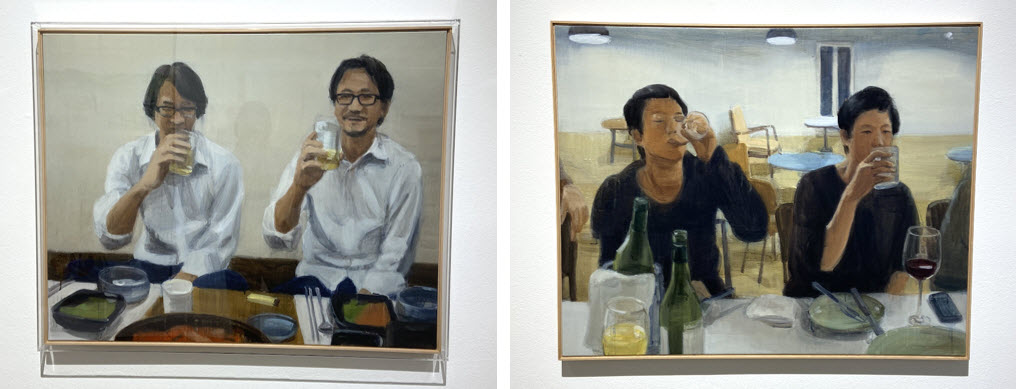
Two Men Drinking (left) and Two Women Drinking (right)
Visitors are immediately greeted by a series of oil paintings that capture the mundane moments which slip by us quickly and quietly. Through her paintings, Jina Park visualizes how an endless number of microscopic moments come together to form the entire timeline of our lives. She suggests that by stepping back to evaluate these fragments of time, we realize that they are just as valuable as the momentous milestones that are easily remembered. Many of Park’s contributions to the exhibition embrace the distinctive dining and drinking culture of Korea.
There are also several installation pieces in this section of the exhibition.
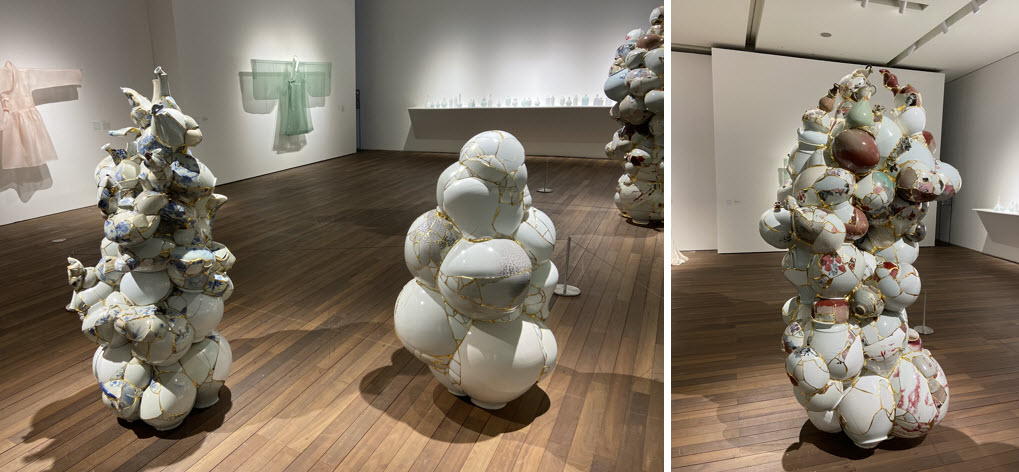
Translated Vase_2014 TVW 2, Translated Vase_2022 TVW 20, and Translated Vase_2014 TVW 15
The striking trio of hulking floor installations, created by artist Sookyung Ye, comprises large chunks of porcelain shards that are lined in gold. These shards are pieced together to form stacks of new vases that merge into one another. The old is taken apart, reimagined, and reassembled into something new and more intricate in composition.
Another eye-catching installation is Do Ho Suh’s Gate-Small. Composed of stainless steel tubing covered in silk, Gate-Small carries all the features of traditional Korean architecture. The intricate designs look as if they are carved into the paper-like surface of the silk.
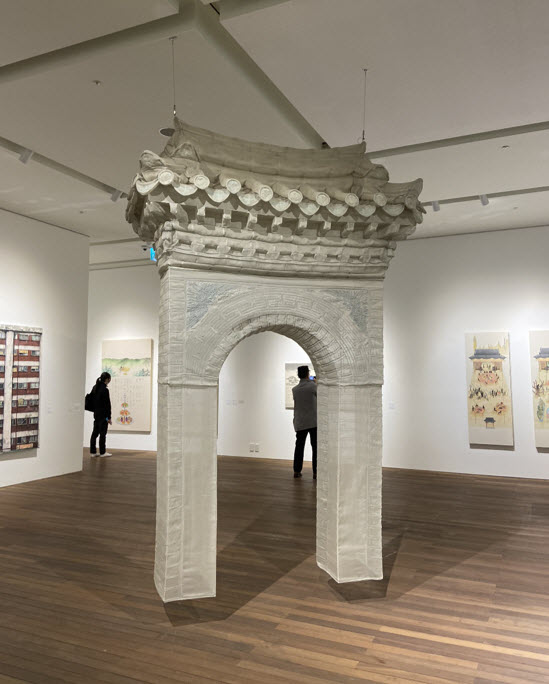
Gate-Small
Through his installation, Suh explores the intersection of place, memory, and the diaspora experience. Suspended in the air and not connected to a larger structure, the gate is not tied down by the spatial concept of a fixed, physical location, and instead, transcends the boundaries of time and space.
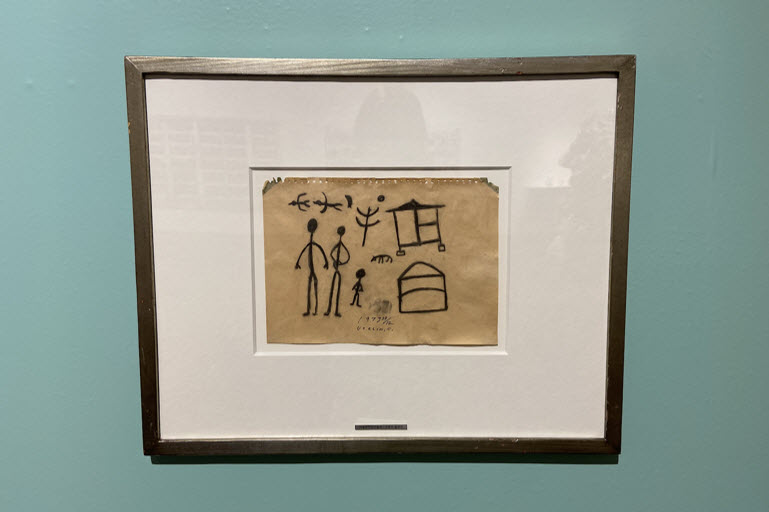
Town
Juxtaposing the elaborate installations are the charcoal drawings by Ucchin Chang, which depict rudimentary stick figures, nature, and houses. These playful drawings are a callback to the past as they are made in the style of children’s drawings. Chang captures the essence of childhood innocence, simplicity, and unapologetic sincerity through his work. Town suggests that these positive elements of the past are things that one should hold onto in the present and into the future.
“Remembrance or Existence”
The third section of the exhibition brings it to a memorable close.
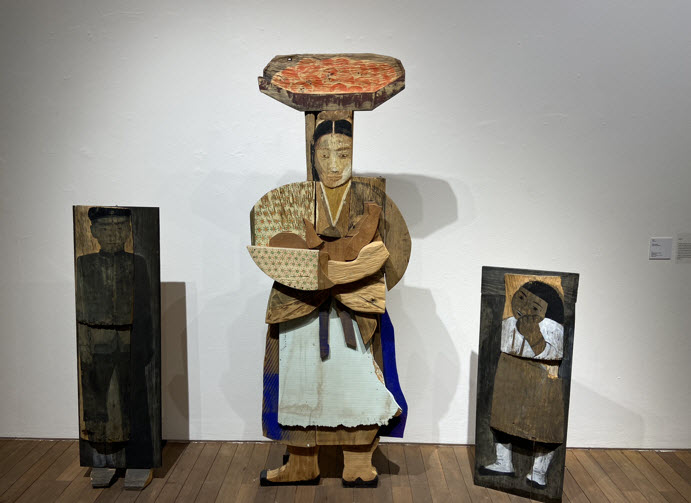
Mother 2 - Daughter and Son
Mother 2 - Daughter and Son is an installation piece created by Suknam Yun, who has long been known as a pioneer in feminist art. Yun portrays the female experience in her many multimedia artworks with care and compassion and allows elements of her personal life to inspire her.
Mother 2 - Daughter and Son is part of a chronology of installations that record the life of women, from the beginning of adulthood to its very end, within the institution of marriage. Discarded wood scraps are repurposed to create this insightful piece.

Boxing, Unboxing
Duck Hyun Cho’s artworks visualize memory and the trend of the times. Boxing, Unboxing, in particular, is an elaborately constructed piece that depicts the physical unboxing of black-and-white portraits of unnamed, unknown people. Through this production, Cho gives attention to the memories of individuals that are lost in the grander scheme of history.
Time States—Contradiction and Accordance is open until May 28. Walk through the exhibition to rediscover the value of tradition in a hectic world that is obsessed with the shiny and new.
Written by Hee Seo Lee, SNU English Editor, heeseolee@snu.ac.kr
Reviewed by Professor Travis Smith, Department of Asian Languages and Civilizations, tlsmith@snu.ac.kr

